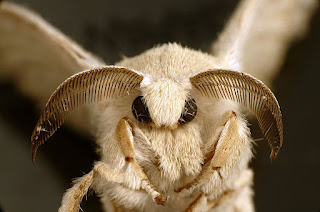By Nancy J. Farrier
 |
| Dragon robe of Emperor Qianlong (18th Century) Photo by Dr. Meierhofer Wikimedia Commons |
Around 3,000 B.C., Empress Hsi-Ling-Shih was walking through her garden drinking her tea when a silkworm cocoon dropped into her tea cup. When she plucked it from the warm tea, the cocoon unwound and she discovered the filament to be a beautiful thread. She realized the worms crawling in the tree overhead were responsible for the cocoon and thus began China’s love of silk and the raising of silkworms.
At first only the royal Emperor, a few of his family, and his highest staff were allowed the precious thread and the clothing made from it. As they learned to cultivate the moths and worms and harvest the cocoons, silk became a form of currency. Often people would be paid for a service with silk cloth.
 |
| Adult Bombyx Mori moth, Wikimedia Commons |
The most common type of moth is the Bombyx Mori, originally believed to be the Bombyx mandarina Moore that lived on the white mulberry tree found in China. The worms, when hatched, were kept in trays in a protected place. (Now between 65° and 77°) They had to be kept away from loud noise and strong smells such as meat, fish, and sweat.
 |
| Trays for silkworms |
 |
| Silk Pavilion Silkworms Wikimedia Commons |
 |
| Laying out Mulberry leaves Wikimedia Commons |
Little by little the knowledge and the silkworms were shared around the world. Still, no one could match the centuries of mastery the Chinese had developed in making silk cloth. Their cloth always brought higher prices because of the beauty and quality.
 |
| Man's Imperial Court Robe 1919 Daderot, Wikimedia Commons |
Today, scientists continue to refine the silk process. By this time the Bombyx moth is completely dependent on mankind. They are flightless and can’t even find a mate unless they are placed close together. Scientists also continue to experiment and hope to develop a moth that will spin metallic thread and other unique types of filaments. China is still the leading producer of silk, a cloth that keeps the wearer cool in the heat and warm in the cold.
Next time something drops in your tea, maybe you should take a closer look. (Smile) I was enjoyed learning about silkworms and their origin. What about you? Do you like wearing silk? I’d love to hear from you.
Click HERE to visit HHH and comment on the blog post.
Nancy J Farrier is an award-winning, best-selling author who lives in Southern Arizona in the Sonoran Desert. She loves the Southwest with its interesting historical past. When Nancy isn’t writing, she loves to read, do needlecraft, play with her cats and dog, and spend time with her family. You can read more about Nancy and her books on her website: nancyjfarrier.com.


I love wearing silk, but taking care of items can be tedious.
ReplyDeleteI agree. I like wash and wear items.
DeleteThanks for posting today. I don't know if I've ever had anything that was pure silk. I'm a no-fuss gal so if it needs special care I probably wouldn't invest in it. I was most impressed by the fact that the Empress didn't just freak out and demand that the worms be banished from the kingdom, because I think that's my typical reaction to crawly things!
ReplyDeleteI know, Connie. I laughed when I read the silkworm dropped in her tea and she was just fascinated by the silk thread. I wonder if she drank the tea. :)
DeleteInteresting article. I have mulberry silk pillow cases, but I don't think I've ever chosen to buy anything silk to wear. It feels nice, but it's not wash and wear.
ReplyDeleteSilk does feel nice but I do like wash and wear.
DeleteNancy, thank you for this fascinating post! When our last horse died, we began searching for ways to use the land. We decided to plant butterfly host and nectar plants. When I spotted our first caterpillars, I reminisced that in the past I would have ran screaming for Mike, if I hadn't, in preparation, read about the life cycles of butterflies and moths. Now I'm even accepting of the huge horned tomato wormed and the gypsy moth larvae. I love silk, but I don't think I've got any in my drawers at this time.
ReplyDeleteDana, thank you for sharing that story. How fun to have the butterflies. I'm still not so accepting of tomato hornworms. :)
ReplyDelete